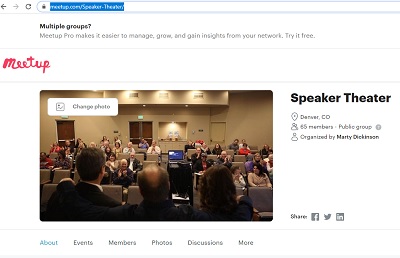Becoming a public speaker is still the best way to get leads for your business. I may be biased, but I am just not seeing any modern-day internet marketing technique that draws “soft sell” leads better than getting in front of a targeted audience and demonstrating your expertise to them in a live setting.
What is Public Speaking?
Public speaking is traditionally known as getting in front of a live audience in a live setting where your audience can see you on stage.
Since you and your audience are in the same room, you have the opportunity to mix and mingle with them before your speech, wander into the crowd if you want to during your speech, and interact with them one-on-one after the speech.
True public speaking has always involved a brick and mortar location with a stage in the front and seating for the audience.
Multiple Forms of Public Speaking in 2020
Of course, public speaking today includes many forms, such as:
- Live traditional stages
- Live videos (Facebook Live, LinkedIn, Twitter)
- One-to-Many webinars
- Interactive live virtual meetings (Zoom)
- Recorded videos (YouTube)
- Podcasts (video and audio)
- Video ads
Each requires a separate set of skills to do a good job for your audience.
Each requires a different approach to acquiring leads and sales for your business.
Are Public Speakers Still in Demand?
Literally hundreds of thousands of events and meetings (online, off-line, public and private) exist every year to bring groups of people together to learn and receive topic specific support from their community.
They all need topic experts to speak to their audiences.
Due to the continuous need for education, and the fact that more people are becoming experts in their field than ever before, more business owners are getting into the public speaking business than in any time in history.
Sure, former sports heroes, celebrity CEOs, political pundits and newscasters are still finding interest in extending their stardom by being on the public live stage. But, I find the biggest influx of new speakers stems from entrepreneurs searching for more leads and sales for their businesses.
The good news: Lots of speaking opportunities are in every state of the U.S.
The challenge: Every public speaker has competition for available speaking opportunities. So, you have to know the game.
The Coronavirus is impacting the speaking industry, offering a temporary setback in already scheduled events cancelling and new speaking events postponing.
Categories
- Blogging Tips (1)
- Business Tips (14)
- Coaching Tips (1)
- Email Marketing Tips (1)
- Event Reviews (1)
- Internet Marketing Tips (10)
- Positive People Progressing Recordings (10)
- Review Forms (1)
- Social Networking Tips (1)
- Speaking Opportunities (2)
- Speaking Tips (6)
- Toastmasters (1)
- Uncategorized (1)
- Video Tips (2)
- Website Tips (3)
Public Speaking is the Oldest Form of Mass Lead Generation
If you were to ask my history junky son, he would tell you merchants have been pitching their wares through public speaking on street corners since the days of Egypt (2000 B.C.) and even before.
There is just no substitute for having a targeted audience in front of you and commanding their attention to listen to you.
Facebook ads and Instagram campaigns can be nerve wracking with endless financial “surprise” credit card deductions and constantly testing and tweaking sales copy. Even those that buy what you’re sellin’ online will enter their credit card numbers with a skeptical eye, just one click away from making a refund request.
But, with public speaking, people see you live and in person. The closer they can get to touching you, the more they realize you are a real person and they’ll want to do business with you because of your visibility as a speaker and the personality your speaking conveys.
Even a terrible speaker can generate interest from at least one or two prospective customers by the end of a speech. But, if you stay in public speaking long enough to get good at it, you could easily find yourself using public speaking as your only lead gen source for your business.
Benefits of Using Public Speaking to Build Your Business
Public speaking allows a business owner to:
- Get in front of many prospects at one time instead of only one by one.
- Uncover a significant problem the audience is having and the solution they should adopt.
- Share in the pain the audience is having and offer them hope.
- Demonstrate one’s industry knowledge and method by offering details of a solution.
- Accumulate testimonials for use in promotions.
- Improve one’s social proof by using photos and logos of past speaking gigs in future promotions.
- Save on advertising costs with literally dozens, if not hundreds, of available local locations to speak.
Best of all, you can get started as a public speaker with little commitment and little time and money investment. So, let’s get to the sequence to help get you started with public speaking for your business.
Getting Help to Get Started with Public Speaking
There are many free Facebook groups to join and programs to buy into and coaches to engage with in the public speaking world. Every year, I attend at least two or three “getting started speaking” seminars to see what people are putting out there.
Personally, I think a new public speaker can benefit in some way from participating in ANY speaking-oriented group or buying into ANY new speaker guidance program. The key is to only spend what you really can afford. You will be tempted to spend more, believe me.
Start searching for information about public speaking or professional speaking, and you will soon be flooded on your Facebook feed with ads for the new and improved “get speaking quick” method.
I, too, work with new and emerging public speakers one-on-one to help them use stages to get more leads for their businesses. Every speaker mentor or coach has her or his own suggested way of getting started in this industry. Here, I’m presenting you with only one way; the method that has worked well for my speaker clients over the past 15 years.
Steps to Getting Started in Public Speaking for Your Business
Step 1: Learn the "Free" Speaking Business
Many new speakers make the mistake of refusing to speak for free…ever! Turning down free local speaking opportunities is definitely the wrong approach to becoming a professional speaker. In fact, if you want to become a professional, paid, speaker, the best thing you can do is find local places to speak for free once or twice per week for your first year. But, more about that in step #4. For now, just learn about the business through a book by the late Joe Sabah, titled,
How to Speak for Fun and Profit.
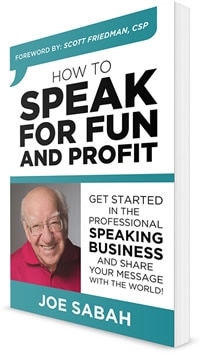
Joe co-founded the Colorado chapter of National Speakers Association and brought literally thousands of new speakers through the process of getting free speaking gigs. We produced his book with the objective of preserving his 36-year seminar into a written form for new speakers to learn from for years to come after his passing, which did occur in late 2019.
Joe’s book walks its readers through the process of finding their topic and creating a speech title. The highlight of the book is a proven script for calling event organizers on the phone and getting booked as a speaker. My personal favorite is the rare history Joe shares during the early days of the public speaking industry, where he toured with speaking legends like Cavett Robert.
Get Joe’s book. It’s a must-read for any new speaker.
Step 2: Join Toastmasters
If you want to become a speaker, you have to simply get speaking…in a supportive environment.

Toastmasters is a great place to start speaking immediately in a small group setting. You can walk in as a guest and observe a meeting for free. Depending on the size of the club, you might even be offered the opportunity to participate in the Table Topics section of the meeting where you would be given 1-2 minutes to respond to an impromptu question. Once a member, you will be scheduled to give a 5-7 minute speech roughly once a month (depending on how many members are in the club as speaking opportunities are rotated among all members).
Participating in Toastmasters involves much more than just giving speeches. Roles are assigned to conduct the meeting. One week you might be assigned to evaluate another speaker. So, you would watch the speech, have a few minutes to prepare a short speech to suggest to the speaker what you felt went well with the speech and what could be improved. You are given 2-3 minutes to present this short review. Although short, critiquing someone else’s speech is of great value to building your own speaking skills.
Another week you might serve as “the Toastmaster for the meeting.” This title is equivalent to the Master of Ceremonies, another very important component in the professional speaking world, and one that’s tough to find opportunities, other than Toastmasters, to practice.
Many new speakers have joined two, three or even five Toastmasters clubs at the same time so that they can literally immerse themselves in speaking several times per week.
To my knowledge, Toastmasters is still the only way to practice speaking on a weekly basis for months, or even years, in front of a supportive group of others trying to expand their speaking skills too. Join at least one club with the intent to be a dedicated member for at least a year. It will take that long for speaking to really become part of you.
Becoming part of at least one Toastmasters club provides new speakers with at least one additional opportunity not normally discussed. It tests you to see if you can commit to frequent speaking.
If you can’t find a way to alter your schedule to attend weekly Toastmasters meetings, how will you ever expect to fit real speaking gigs into your already over leveraged week?
Being a Toastmasters member is a great way to get your feet wet with a speaker’s schedule as well as improving your speaking skills.
Find a Toastmasters club here >>
If you’re in the Denver, Colorado, area, feel free to
visit my Toastmasters club here >>
Step 3: Define Your Purpose - Why Do You Want to Become a Public Speaker?
Do you want more leads for your business? Or, will this be a change of career for you?
Do you plan to start building a product line and bring people in to your product funnel? Or, are you only intested in speaking from stage-to-stage without any sales after you get off the stage?
You could just say “Yes!” to all of those possibilities, and that would be fine. I’m just suggesting that you try to make some of those decisions now so that you gain clarity in your direction.
Step 4: Decide on a Topic
Avoid the temptation to develop a dozen talks for a dozen topics. Big numbers of options just confuse people who hire speakers (SHAs). They want to hire experts and know people can only be a true expert in one or, maybe, two things. Narrow your scope so that you can grow into becoming “The [fill in the blank] Speaker.”
[Note: This is a good place to introduce the acronym I use a lot to identify people who hire speakers. SHA, as you’ll see throughout this post, stands for Speaker Hiring Agent, which could be used instead of the word event planner, meeting planner, educational director, education program coordinator, Executive Director, HR director, marketing manager, speaker review board, and a list of other possibilities.]
One other thing you should know about your public speaker topic…
In the speaking world, topics are labeled as hard or soft. Hard topics are quantitative, such as making money, losing weight, investment advice, starting a business. Soft topics might include spirituality, finding peace or love. None is more or less important. But, there are two very important reasons for determining the weighting of your topic in one direction or the other.
- Audience selection – Knowing whether your topic is hard or soft is important so that you can more logically select potential audiences to speak to. Spirituality speakers are not often seen keynoting Bitcoin summits, for example.
- Coaching compatibility – Like learning anything new, you will eventually need to hire specialty speaking coaches. Speaker coaches excel at one or more components of speaking and assist their speaker client by providing short-term training. Some coaches will simply not work with you if your topic is about making money or selling. Likewise, there are coaches who avoid speakers focusing on soft topics or any topic that might be in conflict with their preferred religion.
Step 5: Develop Your G.E.M.
You are an expert at something. If you are over the age of 20, you have at least ten years experience survivng! If you cannot think of a single thing you are an expert in, you can always turn to your expertise of staying alive. No one else has managed to live as long as you in exactly the way you’ve aged. That sentence alone demonstrates you are authentic (genuine), you are an expert, and you have a method. G.E.M. stands for Genuine Expert Method. Audiences will gladly pay to see you deliver a presentation to provide them with your G.E.M.
In fact, people who hire people to speak (SHAs) are looking for speakers with Genuine Expert Methods to share. Sharing your story is important, and offering humor and entertainment, is still important. But, the days are gone where you can only entertain your audiences. They must walk out of the room with something they can “do” to better their lives or you will likely not make it far as a speaker.
Step 6: Coin Your G.E.M.
My favorite example of coining a G.E.M. is from one of our non-fiction book clients, Susie Hayes. We produced a book for her titled,
FREED from Stuck: Dare to Cross the Bridge Beyond Grief, Trauma and Self-
The word “Freed” became a five letter acronym F.R.E.E.D. to identify her 5-step G.E.M. for treating her therapy clients. Susie is known as the F.R.E.E.D. from Stuck speaker and anyone who hires her to speak knows she will be providing the audience with her own five-step proven method.
There is money, authority and recognition in your method. Own it with an acronym.
Step 7: Develop Your Signature Story
In a recent seminar by Pete Vargas, I was reminded just how important your signature story is. We should all spend more time testing and tweaking the many micro components of our signature stories to achieve the highest impact.
Resulting from the live exercises we performed at the seminar, we learned how your signature story needs to be clearly presentable in as little as 30 seconds. But, you will also use a longer version of that story as a significant percentage of more extensive presentations as well.
The short of it, according to Pete, is that you need to become vulnerable to your audience. Yes, you are the expert today. But, it’s important to reveal that, at one time in your life, you had the same problem as your audience. And, it almost destroyed you! But, then at the last minute, you found one ounce of hope. That hope turned into success. Your method evolved during the pursuit of that successful outcome.
Again, I’ll suggest Toastmasters as a great place to test your signature story content.
Step 8: Write About Your Topic
Here is a step that many new speakers seem to avoid for some reason. Maybe they just feel there is not enough time in a day to write. Maybe they’re just not good at writing or do not enjoy it. Maybe they felt their time would be wasted because no one would ever read what they wrote anyway.
I would have once labeled myself as “all of the above” just a few short years ago. Today, my writing skills and speed of writing have improved, but writing is absolutely a challenge for me—especially if I was to ever attempt to write full non-fiction books the traditional way.
My suggestion with writing is to start small. Find a discussion forum or Facebook group in your niche and start replying to peoples’ posts. Pay particular attention to the words and sentence structure you use to respond to peoples’ questions and concerns. Respond again when participants reply to your replies. Keep the discussion going and begin to enjoy writing as if you are conducting a conversation.
This simple act can greatly increase confidence in your writing quality because of the gratitude people will show you in their responses. Becoming good at writing, like anything, is largely about gaining confidence in your writing efforts.
Step 9: Elevate Your Writing
Once you have gained confidence in your writing, the time will come when your emergence as a speaker will be complimented by your writing of blog posts and eventually a full length, non-fiction, book.
I did not type a word of this blog post. It would take me a week or more to type something like this manually! I would have to allow an extra few hours to stare at a blank page for a while and then write a few sentences, change them, change them again, and yet another blog post would go unfinished.
For my Web Marketing All-in-One for Dummies (Wiley) book, I stayed up every Sunday night–all night–for eight weeks to manually type my 180 pages portion of the co-authored manuscript. Four pots of coffee to stay awake those nights almost killed me! And, I was a mess for three days after each deadline submission due to fatigue and stress.
I had to come up with a better way to produce non-fiction content if I was to ever write another book. The launching of my new book [Due for launch in March 2020]…
Lions Always Win: How to Spot What You Want in Business and Life…and Get it Too, will mark my 22nd produced book. None of the initial manuscript was typed.

No, I didn’t just speak into a voice recorder. No, I didn’t just record my speeches from the stage or hire a ghost writer.
It’s just different.
The output is far better quality than I would ever be able to type on a screen. Best of all, all of the content for the initial manuscript was created in less than a week.
The exact sequence for this new content production method is beyond the scope of this focused public speaking blog post. But, you can learn more about it on our
book writing services here >>.
For now, let’s just say every speaker should have a non-fiction book with their name on it…as soon as possible. I say this everytime I produce a new book for a first-time author: “People just treat you differently when you have a book.” That reality applies to the speaking business too.
Publish or self-publish. It just doesn’t matter as much anymore. What IS important is that you eventually outline your G.E.M. in a book form and get your book available to the public within the next 6-8 months or less, if possible.
Step 10: Settle on Your Speech Headline
I used the word “settle” here because there comes a point where you’re going to have to start speaking and holding yourself out as an availalbe speaker and stop beating yourself up over titles. I’ve seen new speakers delay their pursuit of speaking opportunities for six months because they couldn’t come up with a speech title they’re happy with!
Allow your speech title to evolve over time. Joe Sabah’s book has a nice format for coming up with an initial speech title. If you haven’t bought the book yet, go to Amazon right this minute and get it.
Step 11: Get Your First Three Speaking Gigs
One of the biggest challenges you will face as a new speaker is getting enough speaking gigs before you give up on speaking. You might be excited to get started now, but after a 10 or 15 rejections, will you quit trying to land speaking gigs? Many do and give up way too soon.
Here are three places you can speak within the next month if you really want to take immediate action with your speaking:
1MillionCups.com – Small groups meet weekly around the U.S. They are treated as a networking/educational event, in part, but are also designed for new business owners to present their business and seek advice and feedback from the audience.
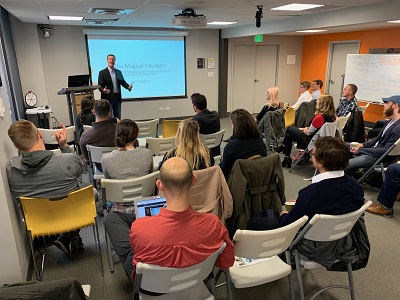
Your presentation can only be five minutes at the typical 1MillionCups event, but then you will usually have another ten minutes of Q&A. Find your local location and then submit online your request for a speaking slot.
Speaker Swap – Do I need to bring up Toastmasters again? Absolutely! Once you are a club member, and have delivered your first or second talk to your club membrers, visit another Toastmasters club and ask the membership if one of their speakers would like to speak at your club at a future date, while, on the same day, you speak at their club. Meaning, you would give a 5-7 minute speech at their club while one of their members speaks in your scheduled speaking spot at your club.
You’ll need to get permission from your club to do this, but I haven’t come across a club yet that has denied such a request.
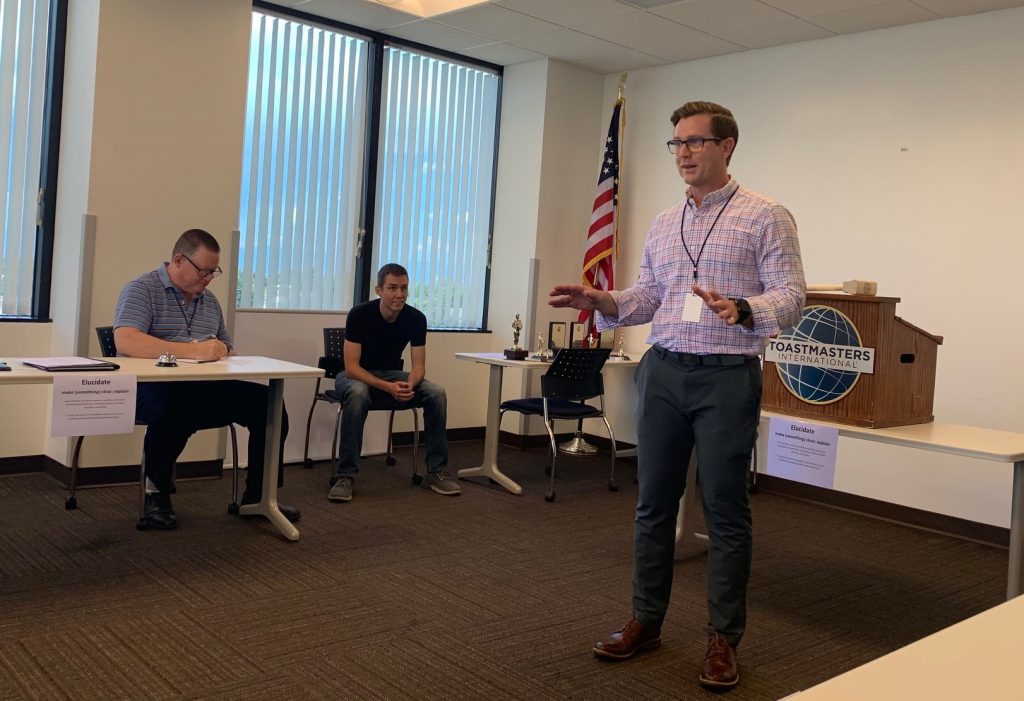
Start a Meetup Group – Sure, attend other meetups and offer to speak to their groups. But, if you want to speak within the next month, consider starting your own meetup group.
I am in the process of doing this now (again) for a new group. We had a prototype live event in December 2019 called, Speaker Theater, for the general public to attend. So, I started a Meetup group at Meetup.com to build a community of new speakers who might want to someday present at a future Speaker Theater. The Meetup group is only for beginning or emerging speakers to support each other.
If you are in the Denver area, and starting or building your speaking business, feel free to
join the group here >>
The idea is to find a restaurant, bar, or another type of business that’s willing to sponsor your meetup event by providing you with a secured meeting room. If food is involved, you will probably have to guarantee a certain number of people and require a certain number to eat or buy drinks.
Then, invite everyone you know to join the group and attend your first event. YOU are guaranteed a speaking spot at every Meetup event you setup.
Step 10: Get Testimonials
Whenever you speak, be sure to carry with you several copies of your testimonial form. Over the past 15 years, I’ve communicated by email, phone and in person with many people who hire speakers. I always ask them about the importance of testimonials. Almost all of them have reported they read EVERY testimonial on a speaker’s website. EVERY single one.
That’s how important testimonials are…and that’s how lacking and unknowing of the game you will appear if you do not have written (or video) testimonials for display.
Make recruiting and collecting testimonials a very important part of every time you get onto a stage. Ask your audience to complete your review form and tell them why testimonials are so important to your ability to get your message out to the world. You will be surprised how such a high percentage of people will comply with your request.
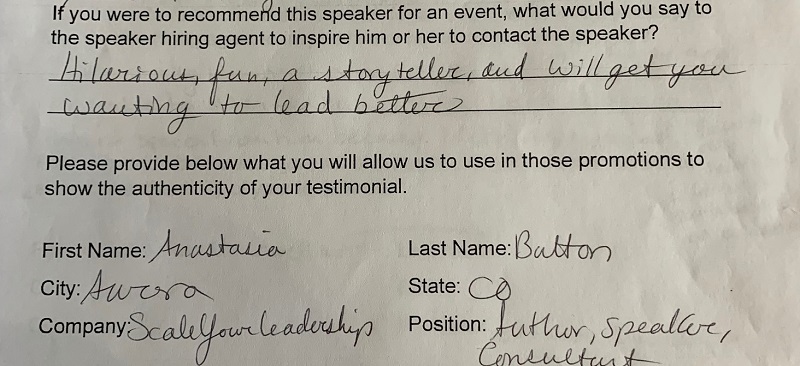
Step 11: Get Video
The great thing about getting started with speaking at local, free, events is that you can almost always get permission to bring a video crew to video your speech. Video EVERY speech you give if at all possible.
You will be speaking at different venues with different room layouts and different sizes of audiences. The video you post for the world to see will be what SHAs (Reminder: SHA stands for Speaker Hiring Agent or the person who decides on speakers for an event) will look for to assure to themselves that you can handle their audience and venue.
Showing a diversity of room type and size helps the SHA to determine their event is not too big or too small for your consideration.
I would personally never hire someone to speak at a 2,000 size audience if their video only shows them speaking to a Toastmasters club of 15, for example.
Record video for the audiences you speak to. As your audiences get bigger, replace old smaller venue videos with the new videos.
Of course, there are many more pieces to the suggestion of “get video” to showcase your speaking that are beyond the scope of this post. For now, just make getting video part of your planning process as you get into the speaking gig discovery process.
Step 12: Have a Speaker Agreement Handy
You should have a speaker agreement on-hand for paid speaking gigs and another for free speaking gigs. You will eliminate many surprises by having a solid agreement in place for each situation.
Don’t worry, people who book speakers think much more highly of you when you supply them with an agreement than if you do not. Having your contracts on-hand shows you know how to play the speaking business game. And, the speaking business is just that…a game.
Step 13: Ignite Your Web Marketing
Notice how I’ve left this step for last? You can take many steps toward using speaking to help grow your business long before you ever pay for a website designer for a speaker website or try to get your website on top of Google search.
Far too many people feel you have to have a website, top search positions on Google, a one-sheet, a bunch of social networks in place, and thousands of Facebook and Twitter followers, before getting speaking gig #1.
This is completely not true! As you will read (hopefully) in Joe Sabah’s book How to Speak for Fun and Profit book, as I recommended, “Speakers Speak!” So, get started!
There is a time and place for websites and social media marketing in the sequence of a new public speaker evolving through the process. But, it can happen at the same time while lining up speaking gigs.
How Getting Started with Speaking Starts the Momentum for Your Business
You’ve heard the saying, “You have to walk before you learn to run.” Speaking is a little bit different. I’ll say it like this, “You have to speak to get speaking more.”
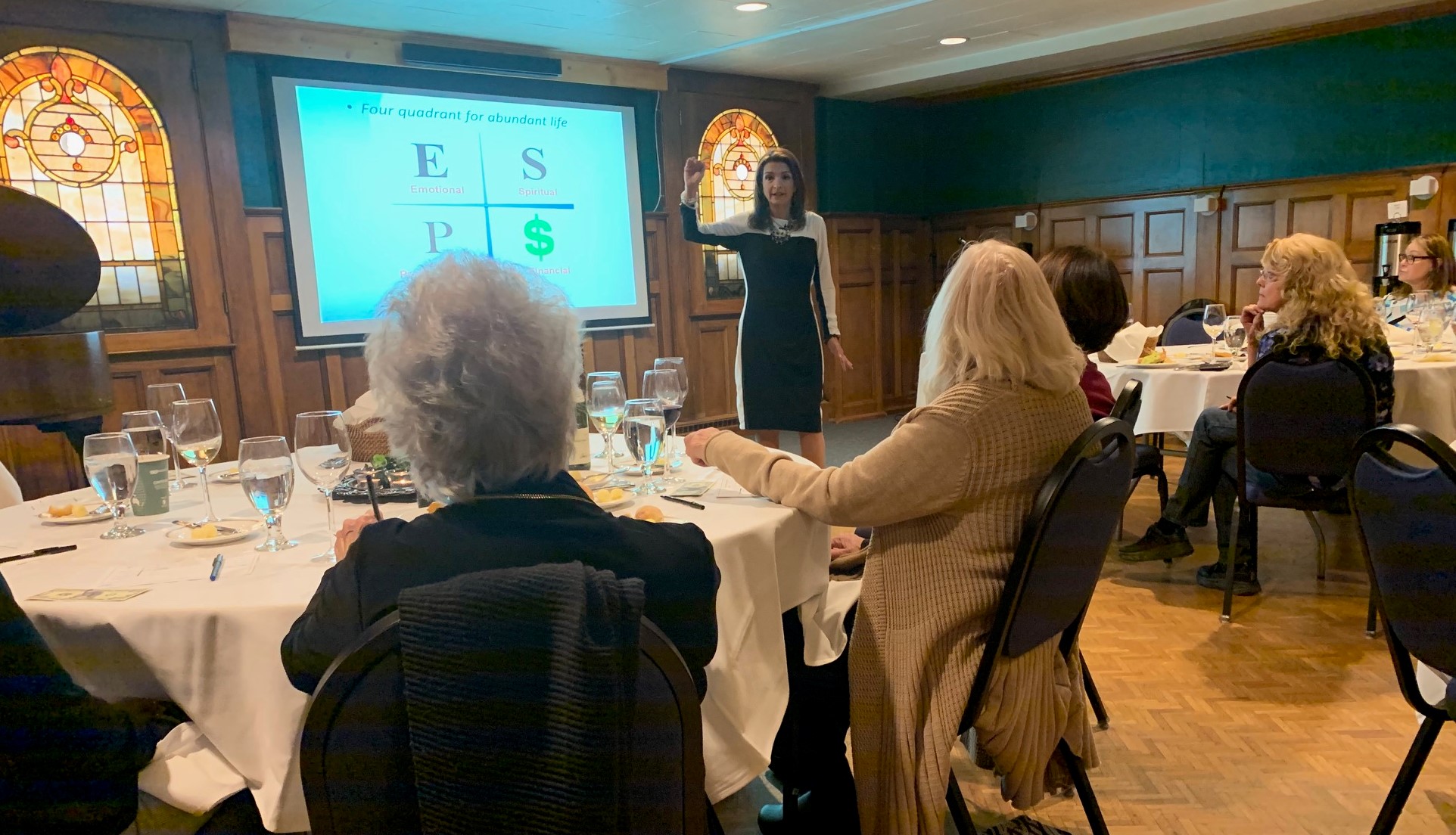 By the time you speak at a big venue with a large audience, my hope and wish for you is that you’ve already spoken to at least 20 different and smaller audiences.
Your message needs to be very clear when you get the opportunity to speak to a large group. Plus, you should want to be experienced with crowds and distractions (and the thousand things that can go wrong) by the time you speak at a multi-hundred or thousand person audience.
Expect to learn about 100 new things during your first three speaking gigs. At that point you’re just experiencing the process.
After that, you’ll really want to start tweaking your message. Your humor will improve. Your stories will have more of an impact on the audience. People from your audiences will start asking if you are available to speak to other groups.
That’s the domino effect at work for your speaking. And, of course, remember too that the more audiences you get in front of, the more leads will follow for your business.
While you’re building momentum in that direction, you can also start submitting Call for Speakers forms to speak in breakout sessions for conferences coming to you home town.
Maybe you’ll organize your own 3-hour, half-day, full-day, or even multi-day event!
By the time you speak at a big venue with a large audience, my hope and wish for you is that you’ve already spoken to at least 20 different and smaller audiences.
Your message needs to be very clear when you get the opportunity to speak to a large group. Plus, you should want to be experienced with crowds and distractions (and the thousand things that can go wrong) by the time you speak at a multi-hundred or thousand person audience.
Expect to learn about 100 new things during your first three speaking gigs. At that point you’re just experiencing the process.
After that, you’ll really want to start tweaking your message. Your humor will improve. Your stories will have more of an impact on the audience. People from your audiences will start asking if you are available to speak to other groups.
That’s the domino effect at work for your speaking. And, of course, remember too that the more audiences you get in front of, the more leads will follow for your business.
While you’re building momentum in that direction, you can also start submitting Call for Speakers forms to speak in breakout sessions for conferences coming to you home town.
Maybe you’ll organize your own 3-hour, half-day, full-day, or even multi-day event!
 Are you starting to see how you can start small and easy and work your way up to more involved speaking gigs? It all begins by getting the momentum started.
Are you starting to see how you can start small and easy and work your way up to more involved speaking gigs? It all begins by getting the momentum started.What is Your Dream Speaking Gig?
I’m going to close this post with a story that encapsulates what public speaking can do for your business. Take a look at this picture.
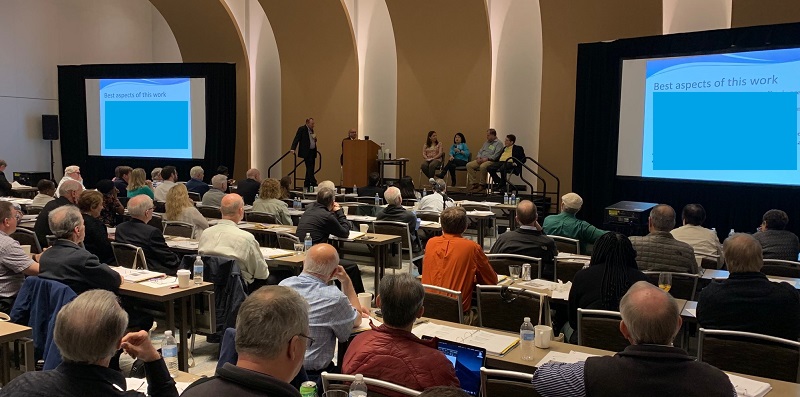
Armin Feldman, M.D. is one of my long-time speaker mentoring and internet marketing clients. He’s the guy leaning against the railing. Once per year, Dr. Feldman gets the opportunity to speak at his dream speaking gig, an annual conference he orchestrates, called the Medical Legal Conference. In 2020, his conference will be in its 7th year.
To many, a self-generated, full room of high-end coaching prospects would be a dream speaking gig. Two days with a few select guest speakers and a panel or two…and the opportunity to showcase yourself as the true expert in your field for the entire event. Public speaking opportunity at its finest.
I never share financial gains of my clients. But, I can tell you that I am extremely proud of Armin’s public speaking success over the years. What a joy to oversee Armin’s website production, the online back-office my team custom developed for him, and the shopping cart I personally manage for him. Armin is a perfect example of how your business can start small, grow as a result of speaking, and then grow much MORE through more speaking.
My point in sharing this example is to showcase two very important facts:
- This size of audience does not happen overnight. The marketing team begins promotion for the next year’s conference only two months after the year’s conference is complete.
- Armin does not make this conference happen by himself! He has a team of ten for running the conference + a devoted marketing team to sell conference tickets. And, yes, Armin has a very dedicated speaker mentor!
If I had to pick one trait that Armin possesses above almost all beginning speakers is patience.
Public Speakers Require Patience
You have to have patience for things to happen as a speaker. You patiently wait to let your topic develop. You have to rely on patience constantly when working with helpers.
Your patience keeps you going when only 20% of your expected audience shows up and even more patience is needed when you have to turn people away when your room is filled to capacity.
Patience is also required when technical glitches occur or when schedule people just don’t show up.
There are so many opportunities for new speakers to lose patience as their speaking career evolves. Many cannot offer the amount of patience required to excel.
Again, for this reason, I suggest that you not try for 20,000 audience sizes right out of the gate. Be patient. Go through the wickets. Start small and work your way up to the larger venues. Speak at free local events first and graduate to your dream speaking gigs. Momentum for your speaking and your business will build with time along with your excitement and experience.
Wrapping it Up
Be action oriented and “get speaking” but also be patient and avoid the temptation to try to get on big stages too soon.
Try not to get too sidetracked by shiny object syndrome. Speaking is a great way to get new leads and sales for your business. People will call you on the phone practically begging you to take them on as clients.
Recognize there are many factors that can stop you in your tracks as you get started in the public speaking field. Some speaking programs and coaches will attempt to delay you from getting started for several months while assembling your speaker platform. Be patient…but persistent.
Be very careful in your choices and find a mentor who’s willing to take an interest in your quest and have the bandwidth to make you their top priority.
If you do not already have an active speaker mentor, and you have a “hard topic,” consider hiring me as your speaker mentor. It’s at least worth a conversation. Send a text message to me requesting a callback at 303-913-4813 or…
Read more about my speaker mentoring program here >>
Above all, remember the great words of the late Joe Sabah where he always said, “Speakers Speak!”


